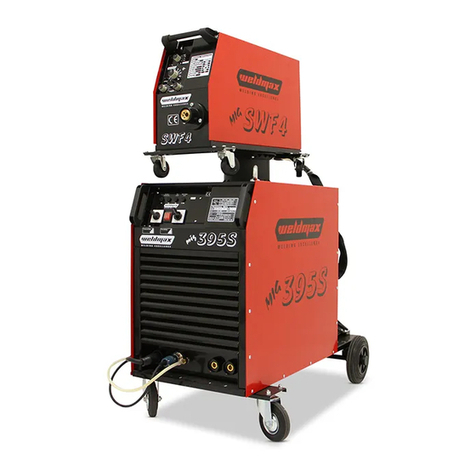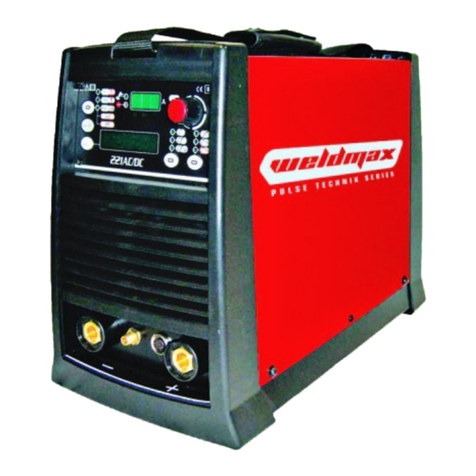
Cod.006.0001.1440
03/06/2013 v2.2
ENGLISH
0
3/28
1INTRODUCTION .....................................................................4
2FRONT PANEL .......................................................................4
3REAR PANEL .........................................................................5
4INSTALLATION ......................................................................5
4.1 CONNECTIONS TO THE ELECTRICAL MAINS NETWORK.5
4.2 PREPARING FOR MMA WELDING........................................5
4.3 PREPARING FOR TIG WELDING ..........................................6
5USER INTERFACE .................................................................8
6UNIT POWER-UP....................................................................9
7RESET (LOAD FACTORY SETTINGS)..................................9
7.1 PARTIAL RESET.....................................................................9
7.2 TOTAL RESET ......................................................................10
8SET-UP (INITIAL SET-UP OF THE WELDING POWER
SOURCE) ..............................................................................10
8.1 TORCH LOADING.................................................................12
9ALARMS MANAGEMENT ....................................................12
THERMAL ALARM! ..........................................................................12
COOLING DEVICE ALARM..............................................................12
10 WELDING PARAMETERS....................................................13
Welding current.................................................................................13
Max welding current..........................................................................13
Hot-start ............................................................................................13
Arc-force............................................................................................13
VRD...................................................................................................13
Long arc voltage ...............................................................................13
Remote control..................................................................................13
Dynamic arc ......................................................................................13
Second current Bi-level.....................................................................13
Base current......................................................................................13
Peak time..........................................................................................14
Base time..........................................................................................14
Pulse frequency ................................................................................14
Slope down .......................................................................................14
Final current......................................................................................14
Post-gas............................................................................................14
Pre-gas..............................................................................................14
Start current ......................................................................................14
Slope up............................................................................................14
Spot TIG time....................................................................................14
HF arc start .......................................................................................14
Minimum pedal current .....................................................................14
Q-start ...............................................................................................14
Multi-tack...........................................................................................14
10.1 PARAMETERS ACTIVATION ...............................................15
11 WELDING SETTINGS...........................................................16
11.1 ELECTRODE WELDING (MMA) ...........................................16
11.1.1 MMA PARAMETERS SETTING (1ST LEVEL).................................16
11.1.2 MMA PARAMETERS SETTING (2ND LEVEL) ................................16
11.1.3 MMA SPECIAL FUNCTIONS ...........................................................16
11.2 DC TIG WELDING.................................................................17
11.2.1 DC TIG PARAMETERS SETTING (1ST LEVEL).............................17
11.2.2 DC TIG PARAMETERS SETTING (2ND LEVEL) ............................17
11.2.3 DC TIG SPECIAL FUNCTIONS MENU............................................18
12 JOBS MANAGEMENT..........................................................19
12.1 SAVING A JOB......................................................................19
12.2 LOADING A USER JOB OF FACTORY SET JOB................19
12.3 DELETING A JOB .................................................................19
13 TORCH TRIGGER MODES ..................................................20
13.1 2T LIFT-ARC WELDING........................................................20
13.2 2T HF WELDING...................................................................20
13.3 4T LIFT-ARC WELDING........................................................20
13.4 4T HF WELDING...................................................................21
13.5 BI-LEVEL LIFT WELDING.....................................................21
13.6 BI-LEVEL HF WELDING .......................................................21
13.7 2T SPOT WELDING..............................................................21
13.8 2T SPOT HF WELDING ........................................................22
13.9 PILOT ARC WELDING..........................................................22
14 TECHNICAL DATA............................................................... 23
15 SPARE PARTS.....................................................................24
16 ELECTRICAL DIAGRAM .....................................................26
16.1 DISCOVERY 300T ................................................................26
16.2 TORCH CONNECTOR .........................................................27
16.3 REMOTE CONTROLLER CONNECTOR .............................27





























